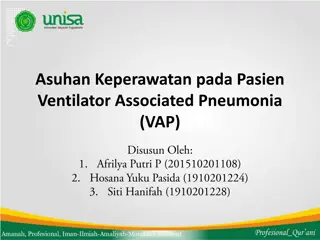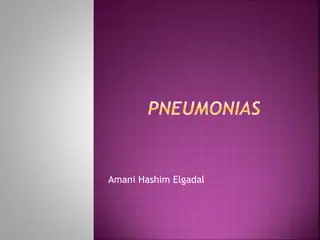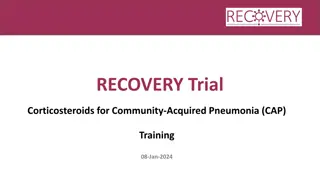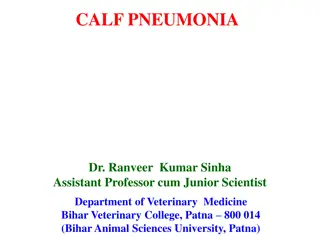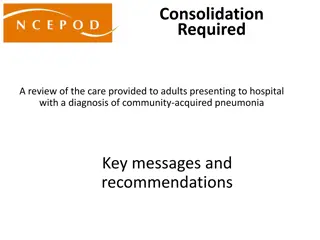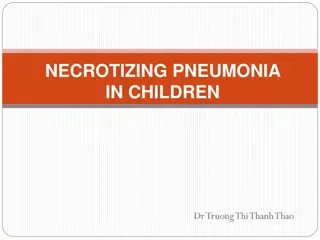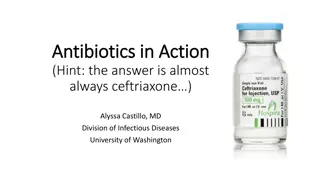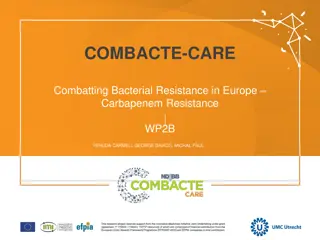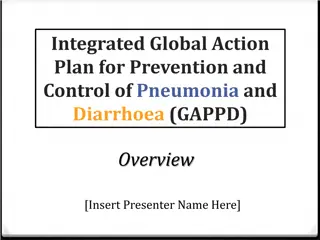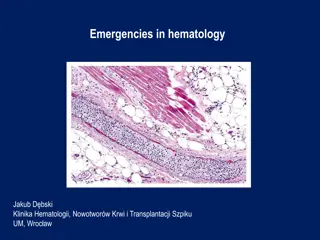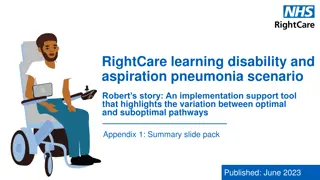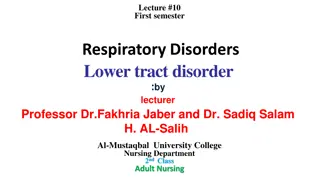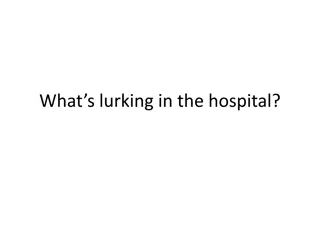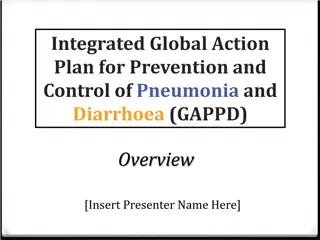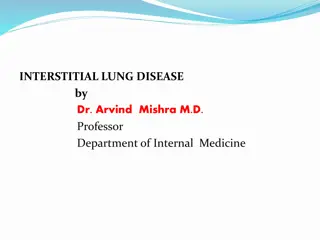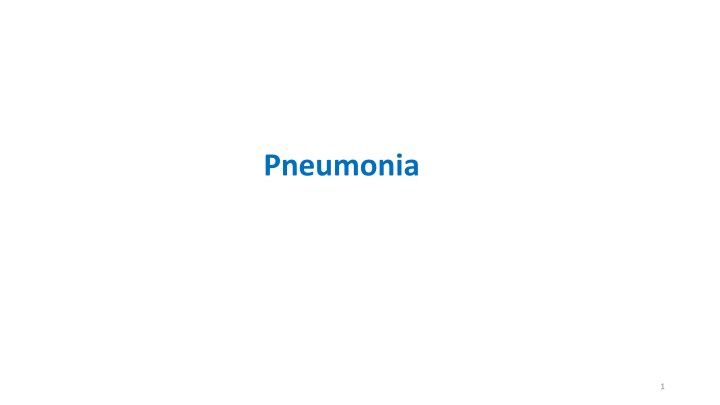
Understanding Pneumonia: Causes, Symptoms, and Defenses
Explore the key aspects of pneumonia, an inflammation and infection of the lungs. Learn about its common causes, symptoms, and the failure of host defenses that can lead to this respiratory illness. Discover predisposing factors and how natural barriers of the body play a crucial role in preventing pneumonia.
Download Presentation

Please find below an Image/Link to download the presentation.
The content on the website is provided AS IS for your information and personal use only. It may not be sold, licensed, or shared on other websites without obtaining consent from the author. If you encounter any issues during the download, it is possible that the publisher has removed the file from their server.
You are allowed to download the files provided on this website for personal or commercial use, subject to the condition that they are used lawfully. All files are the property of their respective owners.
The content on the website is provided AS IS for your information and personal use only. It may not be sold, licensed, or shared on other websites without obtaining consent from the author.
E N D
Presentation Transcript
Pneumonia Pneumonia An inflammation and infection of lung and lung parenchyma Inflammatory infiltrate in alveoli (consolidation) Common illness which occurs in all age group Leading cause of M&M in Infants and Older People & people who are chronically & terminal ill. 2
Pneumonia contd Pneumonia cont d Normally, Lungs Are Well Protected For pneumonia to occur, at least one of the following three conditions must occur: Failure or Defect in Host Defenses Exposure to Very Virulent Pathogens Exposure to an Overwhelming Load of Pathogens 3
Pneumonia contd Pneumonia cont d Host Defenses Natural Barriers of the Body Antibodies or Immunoglobulin Production Cellular Immunity by Phagocytosis 4
Pneumonia contd Pneumonia cont d Failure of Host Defenses Hair of nares Absence of Cough or Epiglottic (Gag) reflex Dysfunctional Muco-ciliary blanket Local production of secretory IgA is reduced Normal flora adhering to mucosal cells of the oro- pharynx 5
Pneumonia contd Pneumonia cont d Failure of Host Defenses cont d Immune Response Stunted: Defective Neutrophil Function Decreased Immunoglobulin Production Prior Viral Infection (Common Cold) Compromises Overall Immunity Systemic Sepsis Weakens Immune Response 6
Pneumonia contd Pneumonia cont d Failure of Host Defenses cont d Immunosuppressive drugs decrease host response Cigarette/second-hand exposure or other toxic fume also weaken lung system Change in mental status (coma, seizure, drug intoxication) 7
Pneumonia contd Pneumonia cont d Predisposing factors Decrease level of consciousness Tracheal intubation Malnutrition Alcohol, cigarette smoking, Stroke, seizures Advanced age Asthma, cystic fibrosis, anemia etc Increased gram-negative bacilli in oro-pharynx 8
Pneumonia contd Pneumonia cont d Cause Pneumonia can result from a variety of causes: Bacterial (Gram-positive bacteria, Gram-negative bacteria, "Atypical" bacteria) Virus Fungi Parasites Chemical or physical injury to the lungs 9
Pneumonia contd Pneumonia cont d Streptococcus pneumoniae Most common cause of uncomplicated in all age groups Atypical Bacteria Mycoplasma Chlamydia Legionella 10
Pneumonia contd Pneumonia cont d Classification Based on causative agent Bacterial or typical pneumonia, Atypical pneumonia According to the X-ray appearance Lobar pneumonia- homogeneous consolidation of one or more lung lobes Broncho- pneumonia- multiple patchy shadows in a localized or segmental area. 11
Pneumonia contd Pneumonia cont d 12
Pneumonia contd Pneumonia cont d 13
Pneumonia contd Pneumonia cont d According to the setting or clinical and environmental Community-acquired pneumonia Hospital-acquired pneumonia Aspiration pneumonia, pneumonia in immuno-compromised host 14
Pneumonia contd Pneumonia cont d Community-acquired pneumonia (CAP) Infectious pneumonia in a person who has not recently been hospitalized & within the first 48 hrs after hospitalization. Common type of pneumonia. Infection usually spread by droplet inhalation. 15
Pneumonia contd Pneumonia cont d Risk factors include: Cigarette smoking Alcohol intake Pre-existing lung disease Old age, etc. 16
Pneumonia contd Pneumonia cont d Common causes Streptococcus pneumoniae (the most common cause) Viruses The atypical bacteria Haemophilus influenza 17
Pneumonia contd Pneumonia cont d Hospital-acquired pneumonia (HAP) Also called nosocomial pneumonia, that acquired during or after hospitalization -at least 48 hours after admission. Up to 5% of patients admitted to a hospital for other causes subsequently develop pneumonia. 18
Pneumonia contd Pneumonia cont d Nosocomial pneumonia is the 2nd most common hospital-acquired infections Nosocomial pneumonia is the leading cause of death from hospital-acquired infections 19
Pneumonia contd Pneumonia cont d Hospitalized patients may have many risk factors for pneumonia: Mechanical ventilation Prolonged malnutrition Underlying heart and lung diseases Decreased amounts of stomach acid Immune disturbances. 20
Pneumonia contd Pneumonia cont d Causative agent More commonly by G(-) organisms, esp. P. aeruginosa Enterobacteriaceae (klebsiella, Enterobacter, Serratia) or MRSA. E.coli H. influenza 21
Pneumonia contd Pneumonia cont d Methicillin-resistant Staphylococcus aureus (MRSA) seen more commonly in patients Received corticosteroids Undergone mechanical ventilation >5 days Presented with chronic lung disease Had prior antibiotics therapy 22
Pathophysiology of Bacterial pneumonia Pathophysiology of Bacterial pneumonia Port of Entry of bacteria to Lungs Port of Entry of bacteria to Lungs -Contiguous extension -Hematogenous Inhalation Aspiration
Pneumonia contd Pneumonia cont d Pathophysiology Once inside, bacteria may invade the spaces b/n cells and b/n alveoli through connecting pores. Invasion triggers the immune system to send neutrophils Neutrophils & macrophages engulf and kill the offending organisms The alveolar macrophages also initiate the inflammatory response 24
Pneumonia contd Pneumonia cont d Pathophysiology It releases cytokines, causing a general activation of the immune system. Neutrophils, bacteria and fluid from surrounding blood vessels fill the alveoli Interrupt normal oxygen transportation and venous blood entering the lungs passes through the under ventilated area. 25
Pneumonia contd Pneumonia cont d Pathophysiology Bacteria often travel from an infected lung into the bloodstream, causing serious or even fatal illness such as septic shock Bacteria can also travel to the area between the lungs and the chest wall (the pleural cavity) causing a complication called an empyema. 26
Pneumonia contd Pneumonia cont d Generally Four stage of pathophysiological change occur due to pneumonia 1. Congestion- occurs during the first 24 hrs Out pouring of fluid from tissue to alveoli- b/se of inflammatory process. Only a few neutrophils are seen at this stage. 27
Pneumonia contd Pneumonia cont d 2. Red hepatization - Lungs look like the liver There is massive capillary dilation Characterized microscopically by the presence of many RBC, neutrophils, micro-organisms , fibrins in the alveolar spaces 28
Pneumonia contd Pneumonia cont d 3. Gray hepatization The lung is dry, friable and gray-brown to yellow as a consequence of a persistent fibrinopurulent exudates WBC and fibrin consolidate the alveoli and lung Second and third stages last for 2 to 3 days each 29
Pneumonia contd Pneumonia cont d 4. Resolution Characterized by enzymatic digestion of the alveolar exudate; Resorption, phagocytosis or coughing up of the residual debris and Restoration of the pulmonary architecture. 30
Pneumonia contd Pneumonia cont d Clinical manifestations Cough producing greenish or yellow sputum High fever that may be accompanied by shaking chills Shortness of breath Tachy pnea Pleuritic chest pain Headaches 31
Pneumonia contd Pneumonia cont d Clinical manifestations Sweaty and clammy (moist) skin, Loss of appetite Fatigue Blueness of the skin Nausea, vomiting Mood swings Joint pains or muscle aches 32
Pneumonia contd Pneumonia cont d Diagnosis History Physical examination Inspection Increase respiratory rate cyanosis Palpation Increase vibration of the chest when speaking The way of chest expands 33
Pneumonia contd Pneumonia cont d Percussion Dullness Auscultation A lack normal breath sounds Crackle sounds Increase loudness of whispered speech Ego phony 34
Pneumonia contd Pneumonia cont d Chest x-ray Chest x-rays can reveal areas of opacity (seen as white) which represent consolidation. Blood tests- a CBC may show a high WBC count. Sputum cultures Chest CT scan or other tests may be needed to distinguish pneumonia from other illness. 35
Pneumonia contd Pneumonia cont d Pneumonia as seen on chest x-rayA: Normal chest x-ray. B: Abnormal chest x-ray 36
Pneumonia contd Pneumonia cont d Medical management Most cases of pneumonia can be treated without hospitalization. Typically, oral antibiotics, rest, fluids and home care are sufficient for complete resolution People with pneumonia who are having trouble breathing, other medical problems & the elderly may need more advanced treatment. 37
Pneumonia contd Pneumonia cont d Medical management E.g. according to DACA For community acquired ambulatory pts (mild pneumonia):- Amoxicillin OR Erythromycin OR Doxycyciline For community acquired hospitalized pts (severe pneumonia):- 39
Pneumonia contd Pneumonia cont d Non-Drug treatment: Bed rest Frequent monitoring of temperature, blood pressure and pulse rate. Give attention to fluid and nutritional replacements. Administer Oxygen Analgesia for chest pain 40
Pneumonia contd Pneumonia cont d Drug treatment: Benzyl penicillin PLUS Gentamicin OR Ceftriaxon. Pneumonia due to staphylococcus aureus should be treated as follows: Cloxacillin 1-2 gm, IV or IM QID for 10-14 days. 41
Pneumonia contd Pneumonia cont d HAP (nosocomial pneumonias) Antimicrobials effective against gram-negative & gram- positive should be given combination. Suitable combination is: Cloxacillin plus Gentamicin OR Ceftriaxon plus Gentamicin Ciprofloxacin Pneumocytis pneumonia responds to Trimethoprin + Sulfamethoxazole 42
Pneumonia contd Pneumonia cont d Complications Shock and respiratory failure Empyema Pleural effusion Atelectasis Abscess formation Bacterimia 43
Pneumonia contd Pneumonia cont d Nursing management The nurse should monitor: Changes in temperature and pulse Amount, odor, and color of secretions Frequency and severity of cough Degree of tachypnea or shortness of breath Changes in physical assessment & chest x-ray findings unusual behavior, altered mental status, dehydration, fatigue 44
Pneumonia contd Pneumonia cont d Nursing diagnoses Ineffective airway clearance related to copious tracheo-bronchial secretions Activity intolerance related to impaired respiratory function Risk for deficient fluid volume related to fever and dyspnea Imbalanced nutrition: less than body requirements 45
Pneumonia contd Pneumonia cont d Nursing intervention Encourages hydration Lung expansion maneuvers- deep breathing, direct coughing Administers oxygen therapy as prescribed. Encourage increased fluid intake (at least 2 L/day) Limited activity and encourage rest Teaching good health habits; such as proper diet and hygiene 46


